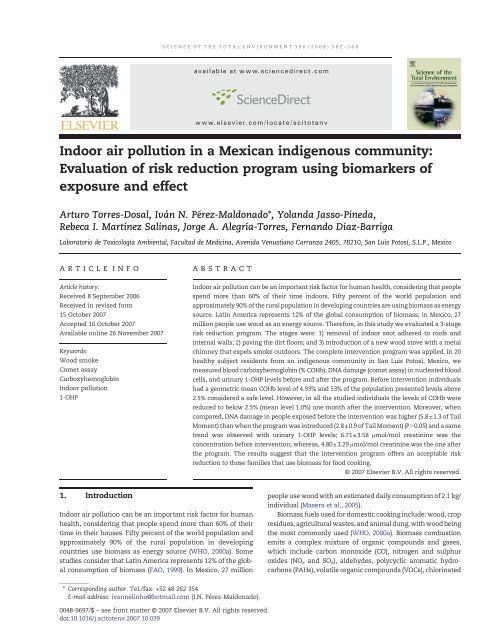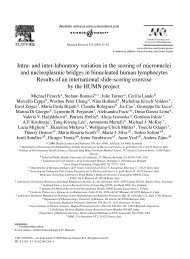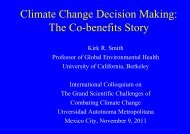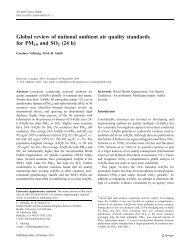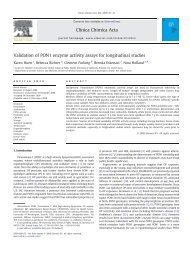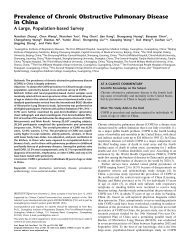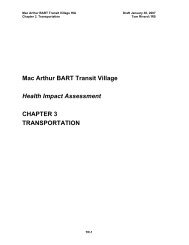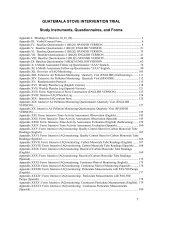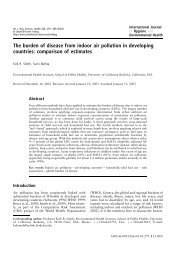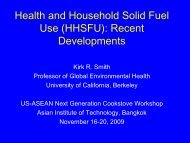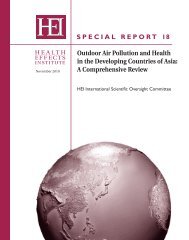Indoor air pollution in a Mexican indigenous community: Evaluation ...
Indoor air pollution in a Mexican indigenous community: Evaluation ...
Indoor air pollution in a Mexican indigenous community: Evaluation ...
You also want an ePaper? Increase the reach of your titles
YUMPU automatically turns print PDFs into web optimized ePapers that Google loves.
S C I E N C E O F T H E T O T A L E N V I R O N M E N T 3 9 0 ( 2 0 0 8 ) 3 6 2 – 3 6 8<br />
ava i l a b l e a t w w w. s c i e n c e d i r e c t . c o m<br />
w w w. e l s ev i e r. c o m / l o c a t e / s c i t o t e n v<br />
<strong>Indoor</strong> <strong>air</strong> <strong>pollution</strong> <strong>in</strong> a <strong>Mexican</strong> <strong>in</strong>digenous <strong>community</strong>:<br />
<strong>Evaluation</strong> of risk reduction program us<strong>in</strong>g biomarkers of<br />
exposure and effect<br />
Arturo Torres-Dosal, Iván N. Pérez-Maldonado⁎, Yolanda Jasso-P<strong>in</strong>eda,<br />
Rebeca I. Martínez Sal<strong>in</strong>as, Jorge A. Alegría-Torres, Fernando Díaz-Barriga<br />
Laboratorio de Toxicología Ambiental, Facultad de Medic<strong>in</strong>a, Avenida Venustiano Carranza 2405, 78210, San Luis Potosí, S.L.P., Mexico<br />
A R T I C L E I N F O<br />
Article history:<br />
Received 8 September 2006<br />
Received <strong>in</strong> revised form<br />
15 October 2007<br />
Accepted 16 October 2007<br />
Available onl<strong>in</strong>e 26 November 2007<br />
Keywords:<br />
Wood smoke<br />
Comet assay<br />
Carboxyhemoglob<strong>in</strong><br />
<strong>Indoor</strong> <strong>pollution</strong><br />
1-OHP<br />
A B S T R A C T<br />
<strong>Indoor</strong> <strong>air</strong> <strong>pollution</strong> can be an important risk factor for human health, consider<strong>in</strong>g that people<br />
spend more than 60% of their time <strong>in</strong>doors. Fifty percent of the world population and<br />
approximately 90% of the rural population <strong>in</strong> develop<strong>in</strong>g countries are us<strong>in</strong>g biomass as energy<br />
source. Lat<strong>in</strong> America represents 12% of the global consumption of biomass; <strong>in</strong> Mexico, 27<br />
million people use wood as an energy source. Therefore, <strong>in</strong> this study we evaluated a 3-stage<br />
risk reduction program. The stages were: 1) removal of <strong>in</strong>door soot adhered to roofs and<br />
<strong>in</strong>ternal walls; 2) pav<strong>in</strong>g the dirt floors; and 3) <strong>in</strong>troduction of a new wood stove with a metal<br />
chimney that expels smoke outdoors. The complete <strong>in</strong>tervention program was applied. In 20<br />
healthy subject residents from an <strong>in</strong>digenous <strong>community</strong> <strong>in</strong> San Luis Potosí, Mexico, we<br />
measured blood carboxyhemoglob<strong>in</strong> (% COHb), DNA damage (comet assay) <strong>in</strong> nucleated blood<br />
cells, and ur<strong>in</strong>ary 1-OHP levels before and after the program. Before <strong>in</strong>tervention <strong>in</strong>dividuals<br />
had a geometric mean COHb level of 4.93% and 53% of the population presented levels above<br />
2.5% considered a safe level. However, <strong>in</strong> all the studied <strong>in</strong>dividuals the levels of COHb were<br />
reduced to below 2.5% (mean level 1.0%) one month after the <strong>in</strong>tervention. Moreover, when<br />
compared, DNA damage <strong>in</strong> people exposed before the <strong>in</strong>tervention was higher (5.8±1.3 of Tail<br />
Moment) than when the program was <strong>in</strong>troduced (2.8±0.9 of Tail Moment) (PN0.05) and a same<br />
trend was observed with ur<strong>in</strong>ary 1-OHP levels; 6.71±3.58 μmol/mol creat<strong>in</strong><strong>in</strong>e was the<br />
concentration before <strong>in</strong>tervention; whereas, 4.80±3.29 μmol/mol creat<strong>in</strong><strong>in</strong>e was the one after<br />
the program. The results suggest that the <strong>in</strong>tervention program offers an acceptable risk<br />
reduction to those families that use biomass for food cook<strong>in</strong>g.<br />
© 2007 Elsevier B.V. All rights reserved.<br />
1. Introduction<br />
<strong>Indoor</strong> <strong>air</strong> <strong>pollution</strong> can be an important risk factor for human<br />
health, consider<strong>in</strong>g that people spend more than 60% of their<br />
time <strong>in</strong> their houses. Fifty percent of the world population and<br />
approximately 90% of the rural population <strong>in</strong> develop<strong>in</strong>g<br />
countries use biomass as energy source (WHO, 2000a). Some<br />
studies consider that Lat<strong>in</strong> America represents 12% of the global<br />
consumption of biomass (FAO, 1999). In Mexico, 27 million<br />
people use wood with an estimated daily consumption of 2.1 kg/<br />
<strong>in</strong>dividual (Masera et al., 2005).<br />
Biomass fuels used for domestic cook<strong>in</strong>g <strong>in</strong>clude: wood, crop<br />
residues, agricultural wastes, and animal dung, with wood be<strong>in</strong>g<br />
the most commonly used (WHO, 2000a). Biomass combustion<br />
emits a complex mixture of organic compounds and gases,<br />
which <strong>in</strong>clude carbon monoxide (CO), nitrogen and sulphur<br />
oxides (NO x and SO x ), aldehydes, polycyclic aromatic hydrocarbons<br />
(PAHs), volatile organic compounds (VOCs), chlor<strong>in</strong>ated<br />
⁎ Correspond<strong>in</strong>g author. Tel./fax: +52 48 262 354.<br />
E-mail address: ivannel<strong>in</strong>ho@hotmail.com (I.N. Pérez-Maldonado).<br />
0048-9697/$ – see front matter © 2007 Elsevier B.V. All rights reserved.<br />
doi:10.1016/j.scitotenv.2007.10.039
S C I E N C E O F T H E T O T A L E N V I R O N M E N T 3 9 0 ( 2 0 0 8 ) 3 6 2 – 3 6 8<br />
363<br />
Fig. 1 – Location of Tancuime <strong>in</strong> San Luis Potosi, Mexico.<br />
diox<strong>in</strong>s, breathable particulate matter (PM) with diameters b10<br />
microns (PM10), and free radicals (Albalak, 2001; Mishra, 2003).<br />
Moreover, wood users rely on simple and rustic stoves such as<br />
open “three-stone” fires and mud, clay, or metal stoves that<br />
result <strong>in</strong> <strong>in</strong>complete and <strong>in</strong>efficient combustion (Reddy et al.,<br />
1997; WHO, 1997).<br />
Health problems associated with <strong>in</strong>door <strong>air</strong> <strong>pollution</strong><br />
<strong>in</strong>clude acute lower respiratory <strong>in</strong>fection among children,<br />
chronic respiratory pulmonary disease (COPD) (WHO, 2002),<br />
asthma (Mishra, 2003; Wallace et al., 2003) low birth weight<br />
(Boy et al., 2002), and an <strong>in</strong>creased risk of tuberculosis (Mishra<br />
et al., 1999). Other reports have described that wood smoke is a<br />
risk factor for several types of cancer, <strong>in</strong>clud<strong>in</strong>g: nasopharyngeal<br />
carc<strong>in</strong>oma, laryngeal, oral (Clifford, 1972; Franco et al.,<br />
1989; P<strong>in</strong>tos et al., 1998) and lung (WHO, 2000b).<br />
S<strong>in</strong>ce carbon monoxide (CO) is probably the most important<br />
s<strong>in</strong>gle contam<strong>in</strong>ant emitted dur<strong>in</strong>g combustion of wood (Viau<br />
et al., 2000), determ<strong>in</strong>ation of its concentration is also important.<br />
In <strong>in</strong>dustrialized countries, concentration limits have<br />
been set at 10 mg/m 3 for outdoor ambient <strong>air</strong>, while occupational<br />
exposure limits lie around 29–55 mg/m 3 (Viau et al.,<br />
2000). Monitor<strong>in</strong>g of <strong>pollution</strong> and personal exposures <strong>in</strong><br />
biomass-burn<strong>in</strong>g households has shown concentration many<br />
times higher than those <strong>in</strong>dustrialized countries (Smith, 1987;<br />
Ezzati et al., 2000; Smith et al., 2000; Smith, 1993; Kammen,<br />
1995; Smith, 1988; Terblanche et al., 1994). For example, CO was<br />
monitored <strong>in</strong> traditional houses <strong>in</strong> Burundi, India, that use<br />
wood combustion as a major energy source, the study revealed<br />
mean concentration of CO reach<strong>in</strong>g 115 mg/m 3 , a value greatly<br />
above the limit <strong>in</strong> <strong>in</strong>dustrialized countries.<br />
A marker use to <strong>in</strong>directly assess CO exposure is carboxyhemoglob<strong>in</strong><br />
(COHb) that reflects b<strong>in</strong>d<strong>in</strong>g of CO to the hem<br />
portion of hemoglob<strong>in</strong>. A concentration of COHb b2.5% is currently<br />
considered safe (Kle<strong>in</strong>man, 2000). The lowest level of<br />
COHb, at which adverse effects are observed, ranges from 2.9 to<br />
3% (Estrella et al., 2005). Moreover, COHb concentrations N5%<br />
are associated with effects, such as neurobehavioral function,<br />
imp<strong>air</strong>ed visual function, task performance, and ma<strong>in</strong>ta<strong>in</strong><strong>in</strong>g<br />
alertness (WHO, 1999; EPA, 2000; Raub and Benignus, 2002).<br />
Polycyclic aromatic hydrocarbons (PAHs) are a group of<br />
three- and four-r<strong>in</strong>g compounds that are formed as a result of<br />
<strong>in</strong>complete combustion. Thus, the exposure to PAHs has also<br />
been used <strong>in</strong> <strong>in</strong>door <strong>air</strong> <strong>pollution</strong> studies (Naumova et al., 2002;<br />
Ohura et al., 2005). Because PAH exposure occurs as a mixture of<br />
compounds, and because pyrene is almost always found <strong>in</strong> this<br />
mixture, pyrene and its metabolite 1-hydroxypyrene (1-OHP) are<br />
considered appropriate surrogate markers of total PAH exposure<br />
(Jacob and Seidel, 2002).<br />
Wood combustion products such as sulfur dioxide, nitrogen<br />
dioxide, total suspended particulate (TSP), PM2.5, PM10, CO,<br />
VOCs, diox<strong>in</strong>s and total hydrocarbons have also been shown to<br />
be mutagenic (Tokiwa et al., 1985; Gao et al., 1994; Y<strong>in</strong> et al., 1998)<br />
and genotoxic <strong>in</strong> “<strong>in</strong> vitro” studies (Brits et al., 2004), <strong>in</strong> exposed<br />
animals (Y<strong>in</strong> et al., 1994) and <strong>in</strong> human populations (Y<strong>in</strong> et al.,<br />
1998; Maffei et al., 2005; Ozturk et al., 2002; Pandey et al., 2005).<br />
On the other hand, diverse <strong>in</strong> vitro, animal and human studies<br />
<strong>in</strong>dicate that exposure to PAH (emitted dur<strong>in</strong>g combustion)<br />
causes genotoxicity (Cebulska-Wasilewska et al., 2005; Xue and<br />
Warshawsky, 2005; Zhao et al., 2004; Lemiere et al., 2004).<br />
Tak<strong>in</strong>g all this <strong>in</strong>formation <strong>in</strong>to account, it is evident that<br />
wood smoke is a serious problem and that <strong>in</strong>tervention<br />
programs are needed to reduce <strong>in</strong>door exposure <strong>in</strong> people that<br />
use biomass as energy source. Therefore, the aim of this study<br />
was to evaluate a risk reduction program us<strong>in</strong>g biomarkers of<br />
exposure (COHb and 1-OHP) and a biomarker of effect (DNA<br />
damage).
364 S C I E N C E O F T H E T O T A L E N V I R O N M E N T 3 9 0 ( 2 0 0 8 ) 3 6 2 – 3 6 8<br />
2. Methods<br />
2.1. Population<br />
We studied 20 healthy subjects (ten houses; 10 children aged<br />
5–17 years and 10 adults aged 20–35 years) residents from the<br />
<strong>in</strong>digenous <strong>community</strong> of Tancuime, Aquismón <strong>in</strong> San Luis<br />
Potosi (Fig. 1). This <strong>community</strong> has 300 families liv<strong>in</strong>g <strong>in</strong><br />
similar conditions. The studied <strong>in</strong>dividuals had a similar<br />
ethnic and socioeconomic background and had lived <strong>in</strong> their<br />
<strong>community</strong> s<strong>in</strong>ce they were born. After <strong>in</strong>formed consent was<br />
obta<strong>in</strong>ed, a questionn<strong>air</strong>e was applied and blood and ur<strong>in</strong>e<br />
samples were taken. Samples of peripheral blood were<br />
collected <strong>in</strong>to hepar<strong>in</strong>ized bottles. The questionn<strong>air</strong>e registered<br />
characteristics such as age, weight, height, smoke<br />
tobacco exposure, pr<strong>in</strong>cipally. Also with this <strong>in</strong>strument, we<br />
registered household and sociodemographic characteristics,<br />
occupation of family members, and food habits. All the<br />
families <strong>in</strong> the study had a low <strong>in</strong>come; they were us<strong>in</strong>g<br />
wood as the only fuel source for food cook<strong>in</strong>g, they live <strong>in</strong><br />
traditional dwell<strong>in</strong>gs (wood-made walls and roof), and usually<br />
spend 60% of their time <strong>in</strong>doors, the average number of<br />
members <strong>in</strong> each family was 5. Anthropometrics assessment<br />
was used for evaluation of the nutritional status.<br />
2.2. Intervention program<br />
An <strong>in</strong>itial census survey of the study area was used to identify<br />
homes with open fires stoves, <strong>in</strong>door soot adhered to roofs and<br />
<strong>in</strong>ternal walls and dirt floors. Thus, for the <strong>in</strong>tervention we<br />
offered 1) removal of <strong>in</strong>door soot adhered to roofs and <strong>in</strong>ternal<br />
walls, 2) pav<strong>in</strong>g dirt floors, and 3) an improved stove (the Patzari<br />
stove), which is constructed us<strong>in</strong>g sand, clay and cement; it also<br />
has a metal chimney that expels the smoke outdoors (Masera<br />
et al., 2007). The complete 3-stage risk reduction program was<br />
applied <strong>in</strong> all houses studied. We applied a questionn<strong>air</strong>e to<br />
confirm that the improved stove was well accepted by people <strong>in</strong><br />
the <strong>community</strong>. The program was <strong>in</strong>troduced <strong>in</strong> ten <strong>in</strong>digenous<br />
houses dur<strong>in</strong>g August 2005; we assessed exposure to carbon<br />
monoxide, PAHs (1-OHP) and DNA damage previously and one<br />
month after the <strong>in</strong>tervention program.<br />
Table 2 – Levels of ur<strong>in</strong>ary 1-OHP before and after risk<br />
reduction program<br />
Stage N Mean±SD (μmol/mol Cr) a Range (μmol/mol Cr)<br />
Before 20 6.72 ±3.58⁎ 1.1–17.8<br />
After 20 4.80±3.29 0.35–18.20<br />
Ur<strong>in</strong>ary 1-OHP was measured as stated <strong>in</strong> Methods.<br />
a Values are geometric data.<br />
⁎pb0.05 when compared after <strong>in</strong>tervention.<br />
and West, (1984). Briefly, 25 μl of whole blood were added to<br />
3 ml of an hemolyz<strong>in</strong>g solution (KH 2 PO 4 /K 2 HPO 4 , 0.01 mol/L,<br />
pH 6.85) <strong>in</strong> a small test tube and mixed. After 5 m<strong>in</strong>, 0.1 ml of<br />
this mixture was <strong>in</strong>troduced <strong>in</strong>to a test tube, which already<br />
conta<strong>in</strong>ed 1.15 ml of a dilut<strong>in</strong>g solution (25 mg of sodium<br />
hydrosulfite <strong>in</strong> 20 ml of buffer just before use). After 10 m<strong>in</strong> the<br />
absorbance was read at 420 and 432 nm aga<strong>in</strong>st a matched test<br />
tube conta<strong>in</strong><strong>in</strong>g only COHb dilut<strong>in</strong>g solution.<br />
2.4. Determ<strong>in</strong>ation of ur<strong>in</strong>ary 1-OHP<br />
We quantified 1-OHP follow<strong>in</strong>g the method described by<br />
Jongeneelen et al. (1987) and Kuusimaki et al. (2004). Under our<br />
conditions, the method detection limits were 0.24 μg/L. Intralaboratory<br />
reproducibility was 16%. The repeatability precision<br />
was 6.0% and recoveries averaged 99%. The ur<strong>in</strong>ary 1-OHP concentrations<br />
were adjusted by ur<strong>in</strong>ary creat<strong>in</strong><strong>in</strong>e. Ur<strong>in</strong>ary creat<strong>in</strong><strong>in</strong>e<br />
was determ<strong>in</strong>ed by the Jaffe colorimetric method, (1982).<br />
2.5. DNA damage<br />
In this work DNA damage was evaluated us<strong>in</strong>g the comet<br />
assay. S<strong>in</strong>gle cell gel electrophoresis was performed as<br />
previously described (Yañez et al., 2003)<br />
2.6. Statistics<br />
To satisfy normality criteria the levels of COHb, ur<strong>in</strong>ary 1-OHP<br />
and Tail Moment were logarithm-transformed. Therefore, all<br />
2.3. Carboxyhemoglob<strong>in</strong> determ<strong>in</strong>ation<br />
COHb was measured by a spectrometry assay and expressed<br />
as a percentage of plasma hemoglob<strong>in</strong> as described by Beutler<br />
Table 1 – Levels of carboxyhemoglob<strong>in</strong> before and after<br />
the risk reduction program<br />
Mean S.D. %b2.5 b %N2.5 c Range<br />
(% COHb) a (% COHb) a (% COHb)<br />
Before 4.9⁎ 4.3 45 55 1.05–13.88<br />
After 1.0 0.14 100 0.0 0.65–1.30<br />
The % of carboxyhemoglob<strong>in</strong> was measured as stated <strong>in</strong> Methods.<br />
a Values are geometric data.<br />
b Percentage of people with levels of carboxyhemoglob<strong>in</strong> below 2.5%.<br />
c Percentage of people with levels of carboxyhemoglob<strong>in</strong> above 2.5%.<br />
⁎pb0.05 when compared after <strong>in</strong>tervention.<br />
Fig. 2 – DNA damage <strong>in</strong> people before and after the risk<br />
reduction program. DNA damage was measured us<strong>in</strong>g the<br />
comet assay (Tail Moment), as stated <strong>in</strong> Methods. Values<br />
are geometric data. ( * ) p b0.05 when compared to before<br />
<strong>in</strong>tervention. (A) Tail Moment before <strong>in</strong>tervention. (B) Tail<br />
Moment after <strong>in</strong>tervention.
S C I E N C E O F T H E T O T A L E N V I R O N M E N T 3 9 0 ( 2 0 0 8 ) 3 6 2 – 3 6 8<br />
365<br />
differences were observed <strong>in</strong> COHb levels when the studied<br />
population was divided by gender or age groups.<br />
Ur<strong>in</strong>ary 1-OHP was used to assess the exposure to PAHs<br />
(Table 2). Results show that the geometric mean level of 1-OHP<br />
before <strong>in</strong>tervention was significantly higher <strong>in</strong> studied people<br />
(6.71±3.58 μmol/mol Cr) than after the program (4.80±3.29 μmol/<br />
mol Cr).<br />
The amount of DNA damage <strong>in</strong> the studied people is depicted<br />
<strong>in</strong> Fig. 2. When compared, DNA damage <strong>in</strong> people<br />
exposed before the <strong>in</strong>tervention was higher (5.8±1.3 of Tail<br />
Moment) than when the program was <strong>in</strong>troduced (2.8±0.9 of<br />
Tail Moment) (Pb0.05). When the studied population was<br />
divided by gender or age groups, we did not observe differences<br />
<strong>in</strong> Tail Moment.<br />
Moreover, significant positive correlation was obta<strong>in</strong>ed<br />
between ur<strong>in</strong>ary 1-OHP and DNA damage <strong>in</strong> blood cells<br />
(Fig. 3a). This correlation was lost when the <strong>in</strong>tervention program<br />
was implemented (Fig. 3b).<br />
4. Discussion<br />
Fig. 3 – Relation between 1-OHP ur<strong>in</strong>ary and DNA damage.<br />
(a) Correlation before <strong>in</strong>tervention program. (b) Correlation<br />
after <strong>in</strong>tervention program.<br />
results are presented as geometric means. For COHb analyses<br />
subjects were divided accord<strong>in</strong>g to COHb levels, us<strong>in</strong>g as a<br />
cutoff po<strong>in</strong>t the concentration of COHb level considered to be<br />
safe (2.5%) (Kle<strong>in</strong>man, 2000). Mean COHb levels, ur<strong>in</strong>ary 1-OHP<br />
and Tail Moment before and after <strong>in</strong>tervention were compared<br />
us<strong>in</strong>g p<strong>air</strong>ed-t test. For all statistical analyses we used Jmp<strong>in</strong><br />
Start Statistics Software 5.0 (SAS Institute).<br />
3. Results<br />
Among the studied volunteers, 65% were females, and 100% of<br />
the participants were not smokers, cot<strong>in</strong><strong>in</strong>e negative (data not<br />
shown). All families were us<strong>in</strong>g wood as the only combustible<br />
available for food cook<strong>in</strong>g.<br />
Table 1 shows the geometric mean COHb level <strong>in</strong> all<br />
subjects studied before and after <strong>in</strong>tervention. Before <strong>in</strong>tervention<br />
all <strong>in</strong>dividuals had a geometric mean COHb level of<br />
4.93% and 55% of those people presented COHb levels above<br />
2.5% considered a safe level. Moreover, this 55% of people had<br />
geometric mean COHb levels of 8.39%. However, <strong>in</strong> all the<br />
studied <strong>in</strong>dividuals the levels of COHb were reduced to below<br />
2.5% (mean level 1.0%) one month after <strong>in</strong>tervention. No<br />
<strong>Indoor</strong> <strong>air</strong> <strong>pollution</strong> has been considered a serious public health<br />
issue <strong>in</strong> Mexico (SSA, 2002). In this regard, Riojas-Rodriguez et al.<br />
(2001), and Zuk et al., (2007), studied the impact of improved<br />
wood burn<strong>in</strong>g stoves on <strong>in</strong>door <strong>air</strong> <strong>pollution</strong> <strong>in</strong> rural communities<br />
<strong>in</strong> Chiapas and Michoacán, Mexico; <strong>in</strong> both studies the use<br />
of stoves reduced the mean levels of PM10 and PM2.5. Moreover,<br />
Riojas-Rodriguez et al. (2001), observed improvements <strong>in</strong> respiratory<br />
symptoms.<br />
We designed a risk reduction program for rural communities<br />
similar to Riojas-Rodriguez et al. (2001) and Zuk et al.<br />
(2007). This program <strong>in</strong>cluded three components: 1) removal of<br />
<strong>in</strong>door soot adhered to roofs and <strong>in</strong>ternal walls; 2) pav<strong>in</strong>g dirt<br />
floors; and 3) <strong>in</strong>troduction of a new wood stove with a metal<br />
chimney that expels smoke outdoors. In this work we are<br />
present<strong>in</strong>g the results of the health impact of such a program,<br />
as we studied biomarkers of exposure (percentage of COHb,<br />
and ur<strong>in</strong>ary 1-OHP) and a biomarker of effect (DNA damage <strong>in</strong><br />
blood cells), before and after the program.<br />
It has been shown that the ma<strong>in</strong> <strong>in</strong>door sources of environmental<br />
CO are smok<strong>in</strong>g and domestic fuel combustion<br />
(Coll<strong>in</strong>gs et al., 1990; Kle<strong>in</strong>man, 2000; Puente-Maestu et al.,<br />
1998). Even a relatively low CO exposure may <strong>in</strong>crease COHb<br />
levels <strong>in</strong> human peripheral blood (Raub and Benignus, 2002).<br />
Higher levels of COHb have been observed <strong>in</strong> smokers compared<br />
with no smokers. In addition, children liv<strong>in</strong>g <strong>in</strong><br />
houses with smokers, wood, coal or gas heat<strong>in</strong>g system<br />
exhibit an <strong>in</strong>crement <strong>in</strong> COHb levels (Vazquez et al., 1997).<br />
The observed COHb levels <strong>in</strong> our study before <strong>in</strong>tervention<br />
were very high, almost half of the <strong>in</strong>dividuals (55%) had a<br />
COHb level consistent with levels associated with effects<br />
(N2.5% of COHb; Raub and Benignus, 2002; WHO, 1999; EPA,<br />
2000). Moreover, <strong>in</strong> comparison with others scenarios, the<br />
mean COHb levels reported <strong>in</strong> our study (4.9%) are high. For<br />
example, a gradient of COHb levels was observed <strong>in</strong> children<br />
with different type of heat<strong>in</strong>g system; COHb concentration<br />
were 0.88 ± 1.34% for wood and coal heat<strong>in</strong>g, 0.58 ± 0.97%<br />
for gas heat<strong>in</strong>g, and 0.28 ± 0.4% for electric system (Vazquez<br />
et al., 1997).
366 S C I E N C E O F T H E T O T A L E N V I R O N M E N T 3 9 0 ( 2 0 0 8 ) 3 6 2 – 3 6 8<br />
In the present study, the geometric mean ur<strong>in</strong>ary 1-OHP<br />
concentration was 6.72 μmol/mol creat<strong>in</strong><strong>in</strong>e (range: 1.1–17.8)<br />
before <strong>in</strong>tervention and it decreased to 4.80 μmol/mol<br />
creat<strong>in</strong><strong>in</strong>e (range: 0.35–18.20) after the program. Both values<br />
are higher than the mean ur<strong>in</strong>ary 1-OHP concentrations from<br />
people throughout the world (range: 0.03–0.76 μmol/mol<br />
creat<strong>in</strong><strong>in</strong>e) (Lev<strong>in</strong>e, 1995; Zhao et al., 1992). These values are<br />
also higher than levels observed <strong>in</strong> people liv<strong>in</strong>g <strong>in</strong> traditional<br />
houses from rural districts <strong>in</strong> Burundi (1.50 μmol/mol creat<strong>in</strong><strong>in</strong>e,<br />
range: 0.26–15.62), that use wood as the pr<strong>in</strong>cipal fuel<br />
(Viau et al., 2000). We don't know the type of wood burned <strong>in</strong><br />
Burundi, but it is possible that the difference <strong>in</strong> exposure<br />
between Mexico (our study) and Burundi is the type of wood<br />
used. It has been shown that different emission rates of PAHs<br />
and other compounds are dependent on fuel and burn<strong>in</strong>g<br />
conditions (Jenk<strong>in</strong>s et al., 1996; Zhang and Smith, 1999;<br />
Mcdonald et al., 2000).<br />
Our data suggest that DNA damage <strong>in</strong> lymphocytes is at<br />
least partially related to exposure to wood smoke, as a relationship<br />
was found between DNA damage <strong>in</strong> lymphocytes and<br />
levels of 1-OHP <strong>in</strong> ur<strong>in</strong>e of people studied before the program<br />
(Fig. 3). Furthermore, DNA damage decreased after the program<br />
was implemented (Fig. 2.). In addition, evidence of<br />
genotoxic effects <strong>in</strong> human exposed to biomass fuel smoke<br />
has been shown (Pandey et al., 2005; Musthapa et al., 2004).<br />
DNA damage assessed with the comet assay <strong>in</strong> lymphocytes<br />
was reported <strong>in</strong> rural Indian women exposed to biomass fuel<br />
smoke (Pandey et al., 2005). In that study, Olive Tail Moment<br />
was 3.83±0.15 (Pandey et al., 2005). In another study, an<br />
<strong>in</strong>crease frequency of micronucleus and chromosomal aberrations<br />
were found <strong>in</strong> exposed women (Musthapa et al., 2004).<br />
Moreover, relationships between 1-OHP ur<strong>in</strong>ary and early<br />
genotoxic effects: siter chromatid exchanges (SCE), micronuclei<br />
(MC), and DNA damage (assessed with comet assay) has<br />
been shown (Buchet et al., 1995; Vanhummelen et al., 1993;<br />
Siw<strong>in</strong>ska et al., 2004).<br />
Usually, risk reduction programs for <strong>in</strong>door <strong>air</strong> <strong>pollution</strong><br />
caused by biomass combustion only <strong>in</strong>clude the <strong>in</strong>stallation of<br />
a stove with a chimney (Chapman et al., 2005; Smith-Sivertsen<br />
et al., 2004; Khushk et al., 2005; Naeher et al., 2000). Those<br />
programs were evaluated either through a decrease of <strong>in</strong>door<br />
<strong>air</strong> <strong>pollution</strong> (Riojas-Rodriguez et al., 2001; Naeher et al., 2000;<br />
Khushk et al., 2005; Zuk et al., 2007) and/or by a reduction <strong>in</strong> the<br />
<strong>in</strong>cidence of diseases related with this k<strong>in</strong>d of contam<strong>in</strong>ation<br />
(Riojas-Rodriguez, et al., 2001; Chapman et al., 2005; Boy et al.,<br />
2000; Smith-Sivertsen et al., 2004). We believe that our study<br />
represents an improvement <strong>in</strong> this area, as we <strong>in</strong>stalled a stove<br />
with a metal chimney that expels smoke outdoors, but also<br />
<strong>in</strong>door soot adher<strong>in</strong>g to roofs and <strong>in</strong>ternal walls was removed,<br />
and dirt floors were paved (it has been shown that biomass<br />
burn<strong>in</strong>g might be the major orig<strong>in</strong> of PAHs <strong>in</strong> rural soil; Zhang<br />
et al., 2006). It is important to mention that soot is a s<strong>in</strong>k of<br />
several chemicals generated dur<strong>in</strong>g combustion (Jonker and<br />
Koelmans, 2002a, 2002b) and moreover, an extremely slow<br />
desorption of PAHs from soot has been demonstrated (Jonker<br />
et al., 2005). Therefore, although we do not have <strong>in</strong>formation<br />
regard<strong>in</strong>g the importance of each stage <strong>in</strong> risk reduction, the<br />
elim<strong>in</strong>ation of soot sources (<strong>in</strong> roofs, walls and dirt floor) is a<br />
relevant action consider<strong>in</strong>g that this material is a s<strong>in</strong>k of<br />
hydrophobic compounds such as PAHs and Diox<strong>in</strong>s. Children<br />
and adults can be exposed to this material, by <strong>in</strong>halation<br />
(<strong>in</strong>door <strong>air</strong> particles), <strong>in</strong>gestion (dust particles) or direct dermal<br />
exposure.<br />
This work was a pilot study and although with the limitation<br />
<strong>in</strong> sample size, the improvement <strong>in</strong> exposure (1-0HP, and COHb)<br />
and effect (comet assay) was so homogeneous that the State<br />
Government of San Luis Potosi, us<strong>in</strong>g the precautionary pr<strong>in</strong>ciple<br />
has expanded the program to different communities. We<br />
are follow<strong>in</strong>g our studies <strong>in</strong> these sites.<br />
Acknowledgments<br />
This work was supported by grants from the Consejo Nacional<br />
de Ciencia y Tecnología, Mexico, FOMIX SLP (FMSLP-2005-CO1-<br />
26), Instituto Potos<strong>in</strong>o de la Juventud and Club Rotario San Luis<br />
Potosí, UNION 2000.<br />
“The work described <strong>in</strong> the manuscript was conducted <strong>in</strong><br />
accordance with national and <strong>in</strong>stitutional guidel<strong>in</strong>es for the<br />
protection of human subjects.”<br />
R E F E R E N C E S<br />
Albalak R. <strong>Indoor</strong> respirable particulate matter concentrations<br />
from an open fire, improved cookstove, and LPG/open fire<br />
comb<strong>in</strong>ation <strong>in</strong> a rural Guatemalan <strong>community</strong>. Environ Sci<br />
Technol 2001;35:2650–5.<br />
Beutler E, West C. Simplified determ<strong>in</strong>ation of carboxyhemoglob<strong>in</strong>.<br />
Cl<strong>in</strong> Chem 1984;30:871–4.<br />
Boy E, Bruce N, Delgado H. Birth weight and exposure to kitchen<br />
wood smoke dur<strong>in</strong>g pregnancy <strong>in</strong> rural Guatemala. Environ<br />
Health Perspect 2002;110:109–14.<br />
Boy E, Bruce N, Smith KR, Delgado H. Fuel efficiency of an<br />
improved wood-burn<strong>in</strong>g stove <strong>in</strong> rural Guatemala: implication<br />
for health, environment and development. Energy Susta<strong>in</strong> Dev<br />
2000;2:21–9.<br />
Brits E, Schoeters G, Verschaeve L. Genotoxicity of PM10 and<br />
extracted organics collected <strong>in</strong> an <strong>in</strong>dustrial, urban and rural<br />
area <strong>in</strong> Flanders, Belgium. Environ Res 2004;96:109–18.<br />
Buchet JP, Ferreira M, Burrion JB, Leroy T, Kirsch-Volders M, Van<br />
Hummelen P, et al. Tumour markers <strong>in</strong> serum, polyam<strong>in</strong>es and<br />
modified nucleosides <strong>in</strong> ur<strong>in</strong>e, and cytogenetic aberration <strong>in</strong><br />
lymphocytes of workers exposed to polycyclic aromatic<br />
hydrocarbons. Am J Ind Med 1995;27:523–43.<br />
Cebulska-Wasilewska A, Wiechec A, Panek A, B<strong>in</strong>kova B, Sram RJ,<br />
Farmer PB. Influence of environmental exposure to<br />
PAHs on the susceptibility of lymphocytes to DNA-damage<br />
<strong>in</strong>duction and on their rep<strong>air</strong> capacity. Mutat Res<br />
2005;588:73–81.<br />
Chapman RS, He X, Bl<strong>air</strong> AE, Lan Q. Improvement <strong>in</strong> household<br />
stoves and risk of chronic obstructive pulmonary disease <strong>in</strong><br />
Xuanwei, Ch<strong>in</strong>a: retrospective cohort study. BMJ<br />
2005;331:1050–6.<br />
Clifford P. Carc<strong>in</strong>ogens <strong>in</strong> the nose and throat: nasopharyngeal<br />
carc<strong>in</strong>oma <strong>in</strong> Kenya. Proc R Soc Med 1972;65:682–6.<br />
Coll<strong>in</strong>gs DA, Sithole SD, Mart<strong>in</strong> KS. <strong>Indoor</strong> woodsmoke <strong>pollution</strong><br />
caus<strong>in</strong>g lower respiratory diseases <strong>in</strong> children. Trop Doct<br />
1990;20:151–5.<br />
Estrella B, Estrella R, Oviedo J, Narváez X, Reyes MT, Gutiérrez M,<br />
et al. Acute respiratory diseases and carboxyhemoglob<strong>in</strong><br />
status <strong>in</strong> school children of Quito, Ecuador. Environ Health<br />
Perspect 2005;113:607–11.<br />
EPA, U. S. Environmental Protection Agency. Air quality criteria for<br />
carbon monoxide. EPA 600/P-99/001F. Wash<strong>in</strong>gton, D.C. Office
S C I E N C E O F T H E T O T A L E N V I R O N M E N T 3 9 0 ( 2 0 0 8 ) 3 6 2 – 3 6 8<br />
367<br />
of Research and Development, U. S. Environmental Protection<br />
Agency; 2000<br />
Ezzati M, Mb<strong>in</strong>da BM, Kammen DM. Comparison of emission<br />
and residential exposure from traditional and improved<br />
biofuel stoves <strong>in</strong> rural Kenya. Environ Sci Technol<br />
2000;34:578–83.<br />
FAO. The Challenge of rural energy poverty <strong>in</strong> develop<strong>in</strong>g<br />
countries. World Energy Council and Food and Agriculture<br />
Organization of the United Nations; 1999.<br />
Franco EL, Kowalski LP, Oliveira BV, Curado MP, Pereira RN, Silva<br />
ME, et al. Risk factors for oral cancer <strong>in</strong> Brazil: a case control<br />
study. Int J Cancer 1989;43:992–1000.<br />
Gao ZX, Tang MD, Yi YZ. Prelim<strong>in</strong>ary study on health effects <strong>in</strong> the<br />
residents exposed to the liquefied petroleum gas. Zhonghua<br />
Yufang Yixue Zazhi 1994;28:154–7.<br />
Jacob J, Seidel A. Biomonitor<strong>in</strong>g of polycyclic aromatic hydrocarbons<br />
<strong>in</strong> human ur<strong>in</strong>e. J Chromatogr B Analyt Technol Biomed Life Sci<br />
2002;778:31–47.<br />
Jaffe rate colorimetric method, 1982. Jaffe rate colorimetric<br />
method for measurement of creat<strong>in</strong><strong>in</strong>e <strong>in</strong> plasma and ur<strong>in</strong>e.<br />
Astra creat<strong>in</strong><strong>in</strong>e chemistry module operat<strong>in</strong>g and service<br />
<strong>in</strong>structions X015-555592A. Brea, Calif. Beckman Instruments,<br />
Inc.; 1982<br />
Jenk<strong>in</strong>s BM, Jones AD, Turn SQ, Williams RB. Emission factors for<br />
polycyclic aromatic hydrocarbons from biomass burn<strong>in</strong>g.<br />
Environ Sci Technol 1996;30:2462–9.<br />
Jongeneelen FJ, Anzion RB, Henderson PT. Determ<strong>in</strong>ation of<br />
hydroxylated metabolites of polycyclic aromatic hydrocarbons<br />
<strong>in</strong> ur<strong>in</strong>e. J Chromatogr 1987;413:227–32.<br />
Jonker MT, Hawthorne SB, Koelmans AA. Extremely slowly<br />
desorb<strong>in</strong>g polycyclic aromatic hydrocarbons from soot and<br />
soot-like materials: evidence by supercritical fluid<br />
extraction. Environ Sci Technol 2005;39(20):7889–95<br />
[Oct 15].<br />
Jonker MTO, Koelmans AA. Sorption of polycyclic aromatic<br />
hydrocarbons and polychlor<strong>in</strong>ated biphenyls to soot<br />
and soot-like materials <strong>in</strong> the aqueous environment:<br />
mechanistic considerations. Environ Sci Technol<br />
2002a;36:3725–34.<br />
Jonker MTO, Koelmans AA. Extraction of polycyclic aromatic<br />
hydrocarbons from soot and sediment: solvent evaluation and<br />
implications for sorption mechanism. Environ Sci Technol<br />
2002b;36:4107–13.<br />
Kammen DM. Cookstoves for the develop<strong>in</strong>g world. Sci Am<br />
1995;273:63–7.<br />
Khushk WA, Fatmi Z, White F, Kadir MM. Health and social impacts<br />
of improved stoves on rural women: a pilot <strong>in</strong>tervention <strong>in</strong><br />
S<strong>in</strong>dh, Pakistan. <strong>Indoor</strong> Air 2005;15:311–6.<br />
Kle<strong>in</strong>man MT. Carbon monoxide: evaluation of current California<br />
<strong>air</strong> quality standards with respect to protection of children.<br />
Prepared for California Air Resources Board, California Office<br />
of Environmental Health Hazard Assessment. Irv<strong>in</strong>e, CA:<br />
University of California Irv<strong>in</strong>e; 2000. [Departament of<br />
Community and Environmental Medic<strong>in</strong>e].<br />
Kuusimaki L, Peltonen Y, Mutanen P, Peltonen K, Savela K. Ur<strong>in</strong>ary<br />
hydroxy-metabolites of naphthalene, phenanthrene and pyrene<br />
as markers of exposure to diesel exhaust. Int Arch Occup Environ<br />
Health 2004;77:23–30.<br />
Lemiere S, Cossu-Leguille C, Bispo A, Jourda<strong>in</strong> MJ, Lanhers MC,<br />
Burnel D, et al. Genotoxicity related to transfer of oil spill<br />
pollutants from mussels to mammals via food. Environ Toxicol<br />
2004;19:387–95.<br />
Lev<strong>in</strong>e JO. First <strong>in</strong>ternational workshop on hydroxypyrene as a<br />
biomarker for PAH exposure <strong>in</strong> man—summary and conclusions.<br />
Sci Total Environ 1995;163:164–8.<br />
Maffei F, Hrelia P, Angel<strong>in</strong>i S, Carbone F, Cantelli Forti G, Barbieri A,<br />
et al. Effects of environmental benzene: micronucleus<br />
frequencies and haematological values <strong>in</strong> traffic police<br />
work<strong>in</strong>g <strong>in</strong> an urban area. Mutan Res 2005;583:1–11.<br />
Masera O, Diaz R, Berrueta V. From cookstoves to cook<strong>in</strong>g systems:<br />
the <strong>in</strong>tegrated program on susta<strong>in</strong>able household energy use<br />
<strong>in</strong> Mexico. Energy Susta<strong>in</strong> Dev 2005;9:25–36.<br />
Masera O, Edwards R, Armendariz-Arnez C, Berrueta V, Johnson M,<br />
Rojas-Bracho L, et al. Impact of Patsari improved cookstoves on<br />
<strong>in</strong>door <strong>air</strong> quality <strong>in</strong> Michoacán, Mexico. Energy Susta<strong>in</strong> Dev<br />
2007;11:45–56.<br />
Mcdonald JD, Ziel<strong>in</strong>ska B, Fujita EM, Sagebiel JC, Chow JC, Watson<br />
JG. F<strong>in</strong>e particle and gaseous emission rates from residential<br />
wood combustion. Environ Sci Technol 2000;34:2080–91.<br />
Mishra VK, Retherford RD, Smith KR. Biomass cook<strong>in</strong>g fuels and<br />
prevalence of tuberculosis <strong>in</strong> India. Int J Infect Dis<br />
1999;3:119–29 [Spr<strong>in</strong>g].<br />
Mishra V. Effect of <strong>in</strong>door <strong>air</strong> <strong>pollution</strong> from biomass combustion<br />
on prevalence of asthma <strong>in</strong> the elderly. Environ Health<br />
Perspect 2003;111:71–8.<br />
Musthapa MS, Lohani M, Tiwari S, Mathur N, Prasad R, Rahman Q.<br />
Cytogenetic biomonitor<strong>in</strong>g of Indian women cook<strong>in</strong>g with<br />
biofuels: micronucleus and chromosomal aberration test <strong>in</strong><br />
peripheral blood lymphocytes. Environ Mol Mutagen<br />
2004;43:243–9.<br />
Naeher LP, Smith KR, Leaderer BP, Mage D, Grajeda R. <strong>Indoor</strong> and<br />
outdoor PM2.5 and CO <strong>in</strong> high- and low-density Guatemalan<br />
villages. J Expo Anal Environ Epidemiol 2000;10:544–51.<br />
Naumova YY, Eisenreich SJ, Turp<strong>in</strong> BJ, Weisel CP, Morandi MT,<br />
Colome SD, et al. Polycyclic aromatic hydrocarbons <strong>in</strong> the<br />
<strong>in</strong>door and outdoor <strong>air</strong> of three cities <strong>in</strong> the U.S. Environ Sci<br />
Technol 2002;36:2552–9.<br />
Ohura T, Noda T, Amagai T, Fusaya M. Prediction of personal<br />
exposure to PM2.5 and carc<strong>in</strong>ogenic polycyclic aromatic<br />
hydrocarbons by their concentration <strong>in</strong> residential<br />
microenvironments. Environ Sci Technol 2005;39:5592–9.<br />
Ozturk S, Vatanserver S, Cefle K, Palanduz S, Guler K, Erten N, et al.<br />
Acute wood or coal exposure with carbon monoxide <strong>in</strong>toxication<br />
<strong>in</strong>duces sister chromatid exchange. J Toxicol Cl<strong>in</strong> Toxicol<br />
2002;40:115–20.<br />
Pandey AK, Bajpayee M, Parmar, Rastogi SK, Mathur N, Seth PK, et al.<br />
DNA damage <strong>in</strong> lymphocytes of rural Indian women exposed to<br />
biomass fuel smoke as assessed by the Comet Assay. Environ<br />
Mol Mutagen 2005;45:435–41.<br />
P<strong>in</strong>tos J, Franco EL, Kowalski LP, Oliveira BV, Curado MP.<br />
Use of wood stoves and risk of cancers of the upper<br />
aero-digestive tract: a case-control study. Int J Epidemiol<br />
1998;27:936–40.<br />
Puente-Maestu L, Bahonza N, Perez MC, Ruiz de Ona JM, Rodríguez<br />
Hermosa JL, Tatay E. Relationship between tobacco smoke<br />
exposure and the concentration of carboxyhemoglob<strong>in</strong> and<br />
hemoglob<strong>in</strong>. Arch Bronconeumol 1998;34:339–43.<br />
Raub JA, Benignus VA. Carbon monoxide and the nervous system.<br />
Neurosci Biobehav Rev 2002;26:925–40.<br />
Reddy AKN, Williams RH, Johansson TB. Energy after Rio: prospects<br />
and challenges. New York: United Nations Development<br />
Programme; 1997.<br />
Riojas-Rodriguez H, Romano-Riquer P, Santos-Burgoa C, Smith KR.<br />
Household firewood use and the health of children and women<br />
of Indian communities <strong>in</strong> Chiapas, Mexico. Int J Occup Environ<br />
Health 2001;7(1):44–53.<br />
Secretaria de Salud de México (SSA). Programa de Acción: Salud<br />
Ambiental. Primera Edición970-721-064-8; 2002.<br />
Smith KR. Fuel combustion, <strong>air</strong> <strong>pollution</strong>, and health: the situation<br />
<strong>in</strong> develop<strong>in</strong>g countries. Annu Revi Energy Environ<br />
1993;18:529–66.<br />
Smith KR. Biofuels, <strong>air</strong> <strong>pollution</strong>, and health: a global review. New<br />
York: Plenum Press; 1987.<br />
Smith KR. Air <strong>pollution</strong>: assess<strong>in</strong>g total exposure <strong>in</strong> develop<strong>in</strong>g<br />
countries. Environment 1988;30:16–34.<br />
Smith KR, Samet JM, Romieu I, Bruce N. <strong>Indoor</strong> <strong>air</strong> <strong>pollution</strong> <strong>in</strong><br />
develop<strong>in</strong>g countries and acute lower respiratory <strong>in</strong>fections <strong>in</strong><br />
children. Thorax 2000;55:518–32.
368 S C I E N C E O F T H E T O T A L E N V I R O N M E N T 3 9 0 ( 2 0 0 8 ) 3 6 2 – 3 6 8<br />
Smith-Sivertsen T, Diaz E, Bruce N, Diaz A, Khalakd<strong>in</strong>a A, Schei<br />
MA, et al. Reduc<strong>in</strong>g <strong>in</strong>door <strong>air</strong> <strong>pollution</strong> with a randomized<br />
<strong>in</strong>tervention design—a presentation of the stove <strong>in</strong>tervention<br />
study <strong>in</strong> the Guatemala Highlands. Nor Epidemiol<br />
2004;14:137–143.<br />
Siw<strong>in</strong>ska E, Mielzynska D, Kapka L. Association between ur<strong>in</strong>ary<br />
1-hydroxypyrene and genotoxic effects <strong>in</strong> coke oven workers.<br />
Occup Environ Med 2004;61:e10.<br />
Terblanche P, Nel R, Gold<strong>in</strong>g T. Household energy sources <strong>in</strong> South<br />
Africa: an overview of the impact of <strong>air</strong> <strong>pollution</strong> on human<br />
health. South Africa: Pretoria; 1994 [CSIR Environmental<br />
Services and Department of M<strong>in</strong>eral and Energy Aff<strong>air</strong>s].<br />
Tokiwa H, Nakagawa R, Horikawa K. Mutagenic/carc<strong>in</strong>ogenic<br />
agents <strong>in</strong> <strong>in</strong>door pollutants; the d<strong>in</strong>itropyrenes generated by<br />
kerosene heaters and fuel gas and liquefied petroleum gas<br />
burners. Mutat Res 1985;157:39–47.<br />
Vanhummelen P, Gennart JP, Buchet JP, Lauwerys R, Kirsch-Volders<br />
M. Biological markers <strong>in</strong> PAHs exposed workers and controls.<br />
Mutat Res 1993;300:231–9.<br />
Vazquez P, Lopez-Herce J, Galaron P, Morello-God<strong>in</strong>o C.<br />
Carboxyhemoglob<strong>in</strong> levels and risk factors of carbon<br />
monoxide poison<strong>in</strong>g <strong>in</strong> children. Med Cl<strong>in</strong> (Barc)<br />
1997;108:1–3.<br />
Viau C, Hakizimana M, Bouchard M. <strong>Indoor</strong> exposure to polycyclic<br />
aromatic hydrocarbons and carbon monoxide <strong>in</strong> traditional<br />
houses <strong>in</strong> Burundi. Int Arch Occup Environ Health<br />
2000;73:331–8.<br />
Wallace LA, Mitchell H, O'Connor GT, Neas L, Lippmann M, Kattan<br />
M, et al. Particle concentrations <strong>in</strong> <strong>in</strong>ner-city homes of children<br />
with asthma: the effect of smok<strong>in</strong>g, cook<strong>in</strong>g, and outdoor<br />
<strong>pollution</strong>. Environ Health Perspec 2003;111:1265–72.<br />
WHO. Health and environment <strong>in</strong> susta<strong>in</strong>able development.<br />
Geneva, Switzerland: World Health Organization; 1997.<br />
WHO. Environmental health criteria 213, carbon monoxide. IPCS,<br />
International Programme on Chemical Safety. Second Ed.<br />
Geneva, Switzerland: World Health Organization; 1999.<br />
WHO. Bullet<strong>in</strong> of the World Health Organization, 78(9). 2000a.<br />
WHO. Address<strong>in</strong>g the l<strong>in</strong>ks between <strong>in</strong>door <strong>air</strong> <strong>pollution</strong>, household<br />
energy and human health. Based on the WHO-USAID Global<br />
Consultation on the Health Impact of <strong>Indoor</strong> Air Pollution and<br />
Household Energy <strong>in</strong> Develop<strong>in</strong>g Countries (Meet<strong>in</strong>g report)<br />
Wash<strong>in</strong>gton, DC; 2000b.<br />
WHO. The health effects of <strong>in</strong>door <strong>air</strong> <strong>pollution</strong> exposure <strong>in</strong><br />
develop<strong>in</strong>g countries; 2002. WHO/SDE/OEH/02.05.<br />
Xue W, Warshawsky D. Metabolic activation of polycyclic and<br />
heterocyclic aromatic hydrocarbons and DNA damage: a<br />
review. Toxicol Appl Pharmacol 2005;206:73–93.<br />
Yañez L, García-Nieto E, Rojas E, Carrizales L, Mejía J, Calderón J, et al.<br />
DNA damage <strong>in</strong> blood cells from children exposed to arsenic and<br />
lead <strong>in</strong> a m<strong>in</strong><strong>in</strong>g area. Environ Res 2003;93:231–40.<br />
Y<strong>in</strong> XJ, Liu JZ, Li YS, Kong XH, Liu H. Mutagenicity and <strong>in</strong>duction<br />
of drug-metaboliz<strong>in</strong>g enzyme activity by LPG combustion<br />
particulates <strong>in</strong> rats. Biomed Environ Sci 1994;7:346–56.<br />
Y<strong>in</strong> XJ, Liu JZ, Kong XH, Chu JH, Wang H, Xiao ZX. Mutagenicity of<br />
ur<strong>in</strong>e from <strong>in</strong>dividuals exposed to LPG combustion products.<br />
Biomed Environ Sci 1998;11:251–7.<br />
Zhang HB, Luo YM, Wong MH, Zhao QG, Zhang GL. Distribution<br />
and concentrations of PAHs <strong>in</strong> Hong Kong soils. Environ Pollut<br />
2006;141:107–14.<br />
Zhang J, Smith KR. Emissions of carbonyl compounds from various<br />
cookstoves <strong>in</strong> Ch<strong>in</strong>a. Environ Sci Technol 1999;33:2311–20.<br />
Zhao ZH, Quan WY, Tian DH. The relationship between polynuclear<br />
aromatic hydrocarbons <strong>in</strong> ambient <strong>air</strong> and 1-hydroxypyrene <strong>in</strong><br />
human ur<strong>in</strong>e. J Environ Sci Health 1992;A27:1949–66.<br />
Zhao HW, Y<strong>in</strong> XJ, Frazer D, Barger MW, Siegel PD, Millecchia L, et al.<br />
Effects of pav<strong>in</strong>g asphalt fume exposure on genotoxic and<br />
mutagenic activities <strong>in</strong> the rat lung. Mutat Res 2004;557:137–49.<br />
Zuk M, Rojas L, Blanco S, Serrano P, Cruz J, Angeles F, et al. The<br />
impact of improved wood-burn<strong>in</strong>g stoves on f<strong>in</strong>e particulate<br />
matter concentrations <strong>in</strong> rural <strong>Mexican</strong> homes. J Expo Sci<br />
Environ Epidemiol 2007;17:224–32.


